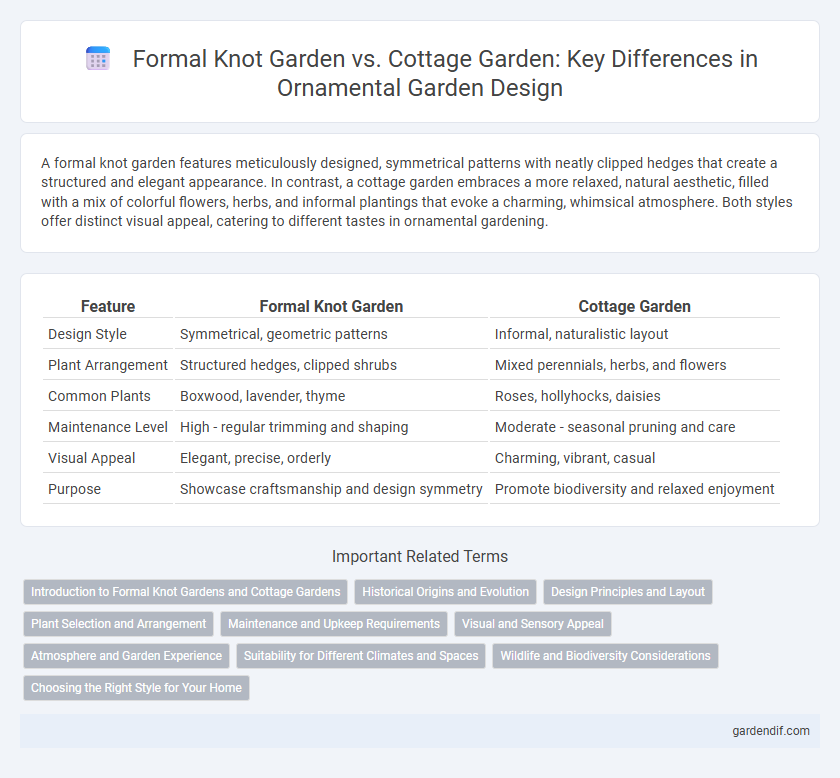
formal knot garden vs cottage garden Illustration
A formal knot garden features meticulously designed, symmetrical patterns with neatly clipped hedges that create a structured and elegant appearance. In contrast, a cottage garden embraces a more relaxed, natural aesthetic, filled with a mix of colorful flowers, herbs, and informal plantings that evoke a charming, whimsical atmosphere. Both styles offer distinct visual appeal, catering to different tastes in ornamental gardening.
Table of Comparison
| Feature | Formal Knot Garden | Cottage Garden |
|---|---|---|
| Design Style | Symmetrical, geometric patterns | Informal, naturalistic layout |
| Plant Arrangement | Structured hedges, clipped shrubs | Mixed perennials, herbs, and flowers |
| Common Plants | Boxwood, lavender, thyme | Roses, hollyhocks, daisies |
| Maintenance Level | High - regular trimming and shaping | Moderate - seasonal pruning and care |
| Visual Appeal | Elegant, precise, orderly | Charming, vibrant, casual |
| Purpose | Showcase craftsmanship and design symmetry | Promote biodiversity and relaxed enjoyment |
Introduction to Formal Knot Gardens and Cottage Gardens
Formal knot gardens feature intricate, symmetrical patterns formed by low hedges, typically boxwood, designed to create a visually striking and orderly appearance. Cottage gardens embrace a more relaxed, informal style, blending a variety of flowering plants, herbs, and shrubs to produce a charming and naturalistic landscape. The structured elegance of formal knot gardens contrasts sharply with the lush, free-flowing character of cottage gardens, each reflecting distinct historical and cultural gardening traditions.
Historical Origins and Evolution
Formal knot gardens originated in the Renaissance period, notably flourishing in 16th-century England and France, characterized by intricate geometric patterns using tightly clipped boxwood hedges. Cottage gardens evolved later, emerging in 19th-century England as informal, densely planted spaces emphasizing a mix of flowers, herbs, and vegetables, reflecting rural domestic life. The evolution of formal knot gardens highlights meticulous design and symmetry, whereas cottage gardens prioritize naturalistic, spontaneous plantings that celebrate biodiversity.
Design Principles and Layout
Formal knot gardens emphasize symmetry and geometric precision, featuring tightly clipped hedges arranged in intricate patterns that create distinct, organized sections. Cottage gardens prioritize an informal, organic layout with a diverse mix of flowering plants and herbs, fostering a natural, overflowing aesthetic. The design principles of formal knot gardens revolve around order and repetition, while cottage gardens embrace spontaneity and variety in plant placement.
Plant Selection and Arrangement
Formal knot gardens prioritize precise geometric patterns using low-growing, evergreen plants such as boxwood, lavender, and thyme to create clearly defined edges. Cottage gardens feature a more informal, densely planted arrangement with a mix of flowering perennials, climbers, and herbs like roses, hollyhocks, and foxgloves to achieve a natural, layered look. The stark contrast between structured symmetry in formal knot gardens and the relaxed diversity in cottage gardens defines their distinct ornamental appeal.
Maintenance and Upkeep Requirements
Formal knot gardens demand meticulous maintenance with precise pruning and regular weeding to preserve their intricate geometric patterns. In contrast, cottage gardens require less intensive upkeep, favoring a more relaxed approach with seasonal pruning and occasional mulching to encourage natural growth. Both styles benefit from routine watering, but formal knot gardens often need more frequent attention to detail to maintain their structured appearance.
Visual and Sensory Appeal
Formal knot gardens showcase meticulously clipped hedges arranged in precise geometric patterns, creating a visually striking and orderly appearance that appeals to those who appreciate symmetry and structure. Cottage gardens offer a more relaxed and natural sensory experience, bursting with a vibrant mix of colorful, fragrant flowers that attract pollinators and delight the senses with their informal charm. The contrast between the sculpted formality of knot gardens and the lush, sensory-rich environment of cottage gardens highlights different approaches to ornamental garden design.
Atmosphere and Garden Experience
Formal knot gardens create a structured and symmetrical atmosphere characterized by intricate geometric patterns and neatly trimmed hedges, offering a sense of order and elegance. Cottage gardens evoke a relaxed and informal experience with their dense, mixed plantings of flowers, herbs, and vegetables, fostering a charming, whimsical ambiance. The formal garden emphasizes precision and visual harmony, while the cottage garden encourages exploration and sensory delight through varied textures and colors.
Suitability for Different Climates and Spaces
Formal knot gardens thrive in temperate climates with well-drained soil and require ample space for their intricate geometric designs, making them ideal for large estates or formal settings. Cottage gardens are more adaptable, tolerating various soil types and climates including wetter or drier conditions, and they suit smaller, informal spaces with mixed flower beds and natural groupings. Both garden styles enhance ornamental aesthetics but demand different maintenance levels and environmental considerations based on climate and available space.
Wildlife and Biodiversity Considerations
Formal knot gardens feature symmetrical, closely clipped hedges and geometric patterns that create limited habitats, reducing opportunities for wildlife nesting and foraging. Cottage gardens, with their diverse, dense plantings of flowering perennials, shrubs, and herbs, support higher biodiversity by providing food sources and shelter for pollinators, birds, and small mammals. Incorporating native plants in cottage gardens enhances ecological connectivity and promotes local wildlife resilience.
Choosing the Right Style for Your Home
Formal knot gardens feature intricate geometric patterns with neatly trimmed hedges, ideal for homes seeking a structured, elegant aesthetic that emphasizes symmetry and order. Cottage gardens offer a more relaxed, natural look with a mix of colorful flowers and greenery, perfect for creating a cozy, whimsical atmosphere that complements rustic or traditional homes. Selecting the right style depends on your home's architectural design and the ambiance you wish to achieve, balancing formality with charm.
formal knot garden vs cottage garden Infographic

 gardendif.com
gardendif.com